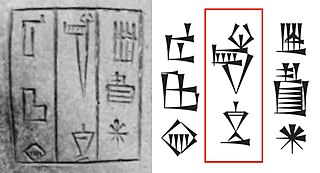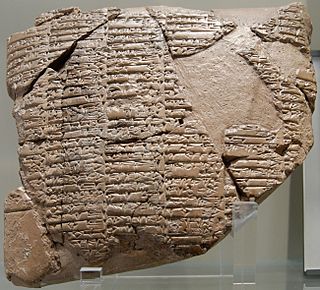Related Research Articles

Elam was an ancient civilization centered in the far west and southwest of modern-day Iran, stretching from the lowlands of what is now Khuzestan and Ilam Province as well as a small part of southern Iraq. The modern name Elam stems from the Sumerian transliteration elam(a), along with the later Akkadian elamtu, and the Elamite haltamti. Elamite states were among the leading political forces of the Ancient Near East. In classical literature, Elam was also known as Susiana, a name derived from its capital Susa.

Untash-Napirisha was king of Elam during the Middle Elamite period, circa 1300 BCE. He was the son of the previous Elamite king, Humban-Numena and of a daughter of Kurigalzu. He was named after Napirisha, an Elamite deity.

The Awan dynasty was the first dynasty of Elam of which very little of anything is known today—appearing at the dawn of recorded history. The dynasty corresponds to the early part of the first Paleo-Elamite period ; additionally, succeeded by the Shimashki and Sukkalmah dynasties. The Elamites were likely major rivals of neighboring Sumer from remotest antiquity—they were said to have been defeated by Enmebaragesi of Kish c. 2750 BC—who is the earliest archaeologically attested king named on the Sumerian King List (SKL); moreover, by a later monarch, Eannatum of Lagash c. 2450 BC. Awan was a city-state or possibly a region of Elam whose precise location is not certain; but, it has been variously conjectured conjectured to have been within the: Ilam and/or Fars provinces of what is today known as the Islamic Republic of Iran, to the north of Susa, close to Dezful, or Godin Tepe.

Shutruk-Nakhunte was king of Elam from about 1184 to 1155 BC, and the second king of the Shutrukid Dynasty.

Shakkanakku, was an Akkadian-language title designating a military governor. Mari was ruled by a dynasty of hereditary Shakkanakkus which was originally set by the Akkadian Empire and gained independence following Akkad's collapse. It is considered that the Shakkanakkus gained some form of independence and came to be considered as "Kings" from the time of Apil-Kin. A critical analysis of the Shakkanakku List of Mari has been published.
Urtak or Urtaku was a king of the ancient kingdom of Elam, which was to the southeast of ancient Babylonia. He ruled from 675 to 664 BCE, his reign overlapping those of the Assyrian kings Esarhaddon (681-669) and Ashurbanipal (668-627).

Teumman was a king of the ancient kingdom of Elam, ruling it from 664 to 653 BCE, contemporary with the Assyrian king Ashurbanipal. In various sources, the name may be found spelled as Te’umman, Teumann, or Te-Umman. For a time, "many scholars, beginning with G.G. Cameron," believed him to have been the Tepti-Huban-Inshushinak mentioned in inscriptions, although this view has since fallen from favor.

Ummanigash was briefly a ruler in the ancient kingdom of Elam, ruling after the beheading of his predecessor Teumman in 653. He ruled part of Elam while his brother, Tammaritu, ruled another. He is also referred to as Humban-nikash II and Khumban-nikash II.
Tammaritu II was the ruler of Elam from 652 until 650 or 649 BC. After the brief reigns of Indabibi and Humban-haltash III, Tammaritu II was briefly restored to power in 648. Tammaritu II was the son of Tammaritu I and the successor of Ummanigash, his uncle.

The Shimashki dynasty was an early dynasty of the ancient region of Elam, to the southeast of Babylonia,. A list of twelve kings of Shimashki is found in the Elamite king-list of Susa, which also contains a list of kings of Awan dynasty. It is uncertain how historically accurate the list is, although some of its kings can be corroborated by their appearance in the records of neighboring peoples. The dynasty corresponds to the second Paleo-Elamite period. It was followed by the Sukkalmah dynasty. Shimashki was likely near today's Masjed Soleyman.

The Sukkalmah or Epartid dynasty, was an early dynasty of West Asia in the ancient region of Elam, to the southeast of Babylonia. It corresponds to the third Paleo-Elamite period. The Sukkalmah dynasty followed the Shimashki dynasty. The title of Sukkalmah means "Grand Regent" and was used by some Elamite rulers. Numerous cuneiform documents and inscriptions remain from this period, particularly from the area of Susa, making the Sukkalmah period one of the best documented in Elamite history.

Khita, sometimes Hita in Elamite, was governor of Susa and the 11th king of the Awan Dynasty of Elam, around 2280 BC. He was most likely the grandfather of the famous Elamite ruler Kutik-Inshushinak, who succeeded him on the throne.
Awan was an ancient city-state or region of Elam in the western area of modern-day Iran. It often appears together with the cities of Susa and Anshan in the early history of Mesopotamia, having many conflictual interactions with Sumer.

Epirmupi was a ruler of Elam around 2199–2154 BCE. His name is purely Akkadian, and he was in charge of Elam at the time of Rimush and Manishtushu, or early in the reign of Naram-Sin and probably their dependent and vassal. His title of "Military Governor" suggests that he was a dependent of the Akkadian kings, rather than an independent ruler. He also held the title of Ensi of Susa".

Tammaritu I, son of Urtak, was briefly a ruler in the ancient kingdom of Elam, ruling after the beheading of his predecessor Teumman in 653. He ruled part of Elam while his brother, Ummanigash, ruled another.
Simut or Šimut (Shimut) was an Elamite god. He was regarded as the herald of the gods, and was associated with the planet Mars. He was closely associated with Manzat, a goddess representing the rainbow. He appears in inscriptions of various Elamite kings which mention a number of temples dedicated to him. However, it is not known which city served as his main cult center. He was also worshiped in Mesopotamia, where he was compared with the war god Nergal.

The Shutrukid dynasty was a dynasty of the Elamite empire, in modern Iran. Under the Shutrukids, Elam reached a height in power.

Indattu-Inshushinak II, often referred to by the shortened name Indattu or Idaddu II, was the tenth king of Elam who came from the dynasty of Shimashki, a city of unknown location.
References
- ↑ Carter, Elizabeth; Stolper, Matthew W. (1984). Elam: Surveys of Political History and Archaeology. University of California Press. p. 29.
- ↑ Edwards, I.E.S. (1973). The Cambridge Ancient History, Vol. 2, Part 1. Cambridge University Press. p. 264.